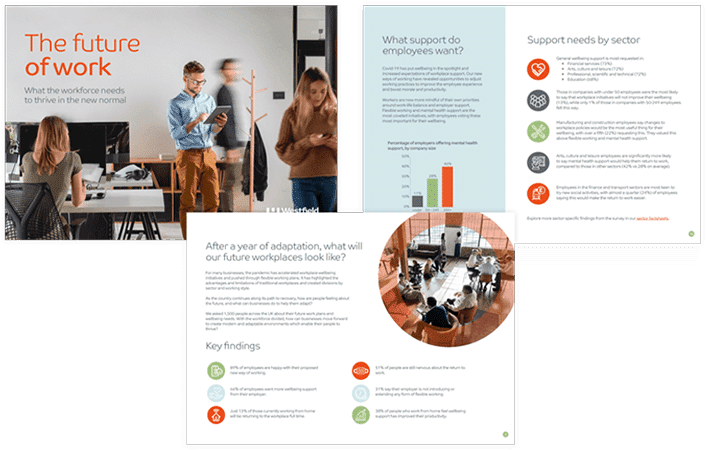As the country awaits news of the next stage of the Government’s Covid-19 roadmap, employers are preparing changes of their own. After a year of disruption, be it getting to grips with furlough, arranging remote working or making the workplace Covid secure, leaders are now faced with the challenge of returning their business to a sense of normality.
Employees across different sectors have been working very differently, each experiencing the pandemic in their own unique way. So how are people feeling about the future, and what support do they need over the coming months?
In our latest research, we asked 1,500 people about their views on the new normal workplace, including return to work anxiety, flexible working and wellbeing support. The Future of Work report explores proposed working styles and the limitations of traditional workspaces, plus the most-requested wellbeing initiatives by employees.
Key findings
- 51% of people are still nervous about the return to work, and 66% of employees are looking for more wellbeing support from their employer.
- 89% of employees are happy with their proposed new way of working, but some sectors are significantly more dissatisfied than others.
- 31% say their employer is not introducing or extending any form of flexible working.
- 38% feel more productive working from home, and just 13% of remote workers will be returning to the workplace full time.
- 42% of workers will be going into the office full time, but 21% still haven’t been told their employer’s plans.
- 43% of people who work from home feel wellbeing support has improved their engagement.
Expectations for the new normal
Even as we approach the final stage of the roadmap, uncertainty remains a problem for many. Over a fifth (21%) of employees haven’t been told how they’ll be working in the coming months.
Of those who have been told, 42% will be going into their place of work full time, up from 36% during lockdown. Working from home will still be commonplace, with 22% working from home full time and 12% adopting a hybrid approach.

The majority of employees (89%) are happy with their employer’s approach, but some have struggled with communication. Of those who’ve been on furlough, only 28% reporting they are ‘very satisfied’ with how their employer has communicated with them, compared with 49% of people who have been working from home.
Flexible working
As might be expected, opportunities for flexible working vary between sectors. In manufacturing and construction, 28% of employees are unhappy with their flexible working options, compared to just 7% of government workers.
While many options are available in theory – working from home, reduced hours, altered start times – flexible working policies differ significantly between different sectors and working styles. There’s a clear division between those who have the option from home (37%) and those who have no flexible working options available to them at all (31%). When considering just those going into work full time, employees without flexible working rises to 56%.

Only 6% of those who have been homeworking feel that their productivity has decreased as a result, while 43% feel more engaged.
What support do employees need?
When asked about workplace anxiety, employee opinions are split. With 51% worried about going into work, employers must be careful not to assume that their people are ready to bounce back after restrictions ease.

In fact, two thirds (66%) of employees are looking for further wellbeing support in the coming months. The most-requested initiatives are:
- Flexible working options
- Mental health support
- Policies to support wellbeing
- Fast access to healthcare
With over a quarter (26%) of businesses offering no key wellbeing initiatives, there is a real opportunity for leaders to invest in the future by investing in their people. As workers across the country prepare for further change, businesses must develop adaptable workplace policies and environments which allow their people to thrive.
Download the full report and factsheets
For an in-depth look at the findings, you can download the full report as a free PDF.

The future of work: what the workforce needs to thrive in the new normal
To find out about the key challenges in your sector, try our quick-reference factsheets.

Sectors include:
- Manufacturing and construction
- Wholesale and retail
- Government
- Education
- Financial services
- Transport and logistics
- Professional, scientific and technical services.